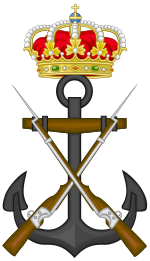Spanish Marines
| Spanish Navy Marines Infantería de Marina |
|
|---|---|
|
Badge of the Spanish Navy Marine
|
|
| Active | February 27, 1537 – present (479 years, 11 months) |
| Country |
|
| Branch |
|
| Type | Marines |
| Role | Amphibious Warfare |
| Size | 4,680 Marines |
| Garrison/HQ | San Fernando |
| Motto(s) |
"Per Terra et Mare" ("By Land and Sea!") |
| March | Marcha heroica de la Infantería de Marina |
| Anniversaries | February 27th |
| Engagements |
Battle of Lepanto War of Jenkins' Ear Siege of Pensacola Spanish–American War Rif War Spanish Civil War |
| Commanders | |
| Current commander |
Major General Pablo Miguel Bermudo y de Espinosa |
The Spanish Navy Marines (Spanish: Infantería de Marina; lit, Naval infantry) is a corps within the Armada (as it is called the Spanish Navy in Spanish language) responsible for providing amphibious warfare from the sea utilizing naval platforms and resources. It is fully integrated into the Armada structure.
The Corps was formed in 1537 by Charles I of Spain (also known as Charles V, Holy Roman Emperor), making it the oldest marine corps in existence in the world, drawing from the Compañías Viejas del Mar de Nápoles.
The Spanish Navy Marines is an elite corps, highly specialised in amphibious warfare, that is, to project an amphibious force onto a hostile, or potentially hostile, coast. Its ability to embark on a short term notice with (land, air and naval) Navy assets, makes it a unit with a high strategic value. Adding to this a high degree of training, and the capability to deploy swiftly in international waters, results in a potent dissuasive force available at a short notice in distant regions.
One of the main characteristics of a marine is the uniform that he wears. On the sleeves of the Spanish Marines are the three "Sardinetas", which marks it as a member of the Royal House Corps. This was given in recognition for a heroic last stand in the Castillo del Morro of Havana, Cuba against a British expedition in 1762. The only other unit to wear the sardinetas and red trouser stripes is the Spanish Royal Guard. Spanish Marines have modern assets to comply with its mission, having personnel specialised in artillery, sapping, helicopters, special operations, communications, tanks, among others. Some vehicles form the Grupo Mecanizado Anfibio del Tercio de Armada (the Mechanized Amphibious Group of the Navy Tercio).
...
Wikipedia

